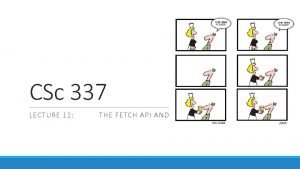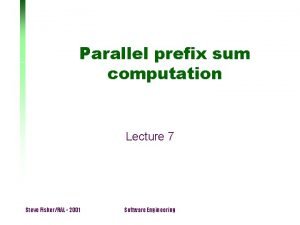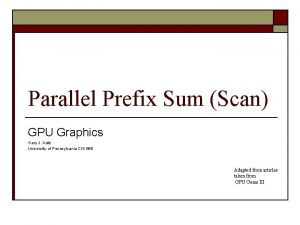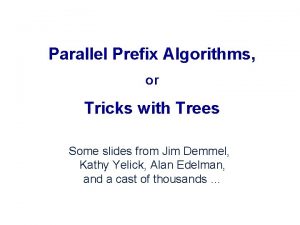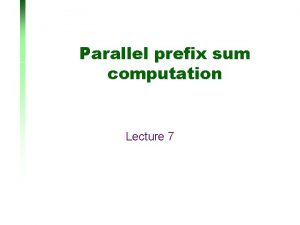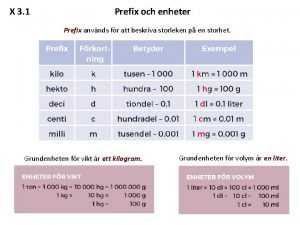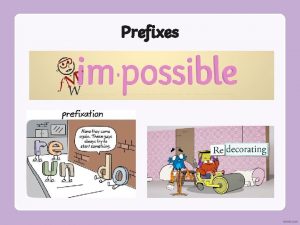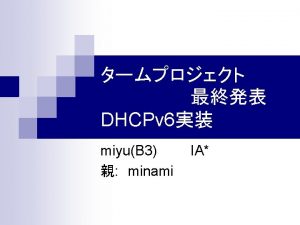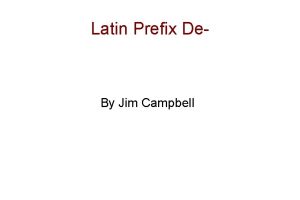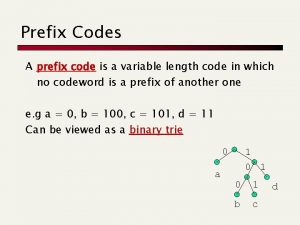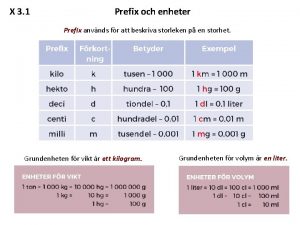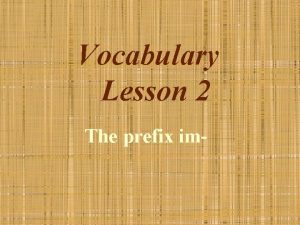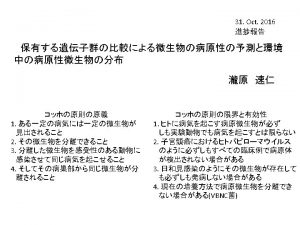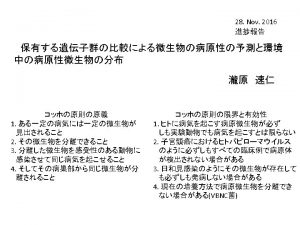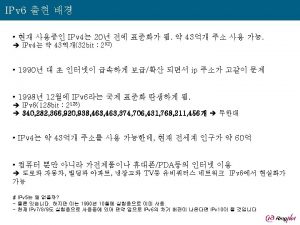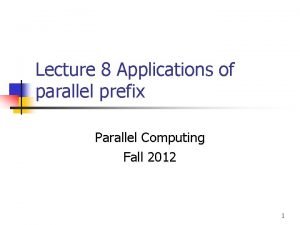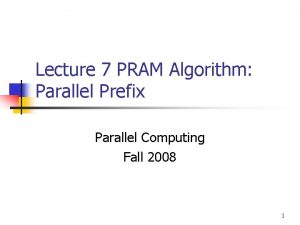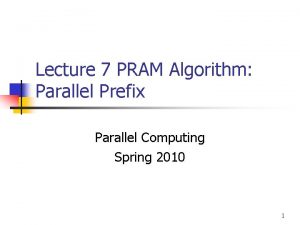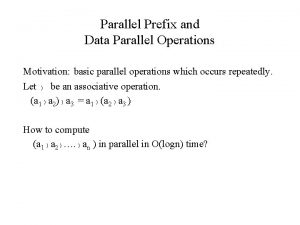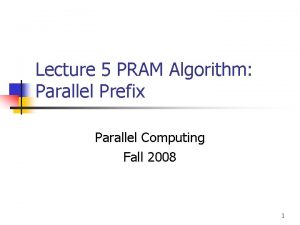18 337 Parallel Prefix 18 337 The Parallel








![Parallel Prefix Recursive View prefix( [1 2 3 4 5 6 7 8])=[1 3 Parallel Prefix Recursive View prefix( [1 2 3 4 5 6 7 8])=[1 3](https://slidetodoc.com/presentation_image_h2/dbdc58ceb9574b3e1576694409c0b4f0/image-9.jpg)










![[ ] Tridiagonal Factor a 1 b 1 c 1 a 2 b 2 [ ] Tridiagonal Factor a 1 b 1 c 1 a 2 b 2](https://slidetodoc.com/presentation_image_h2/dbdc58ceb9574b3e1576694409c0b4f0/image-20.jpg)








![Parallel Prefix prefix( [1 2 3 4 5 6 7 8])=[1 3 6 10 Parallel Prefix prefix( [1 2 3 4 5 6 7 8])=[1 3 6 10](https://slidetodoc.com/presentation_image_h2/dbdc58ceb9574b3e1576694409c0b4f0/image-29.jpg)
![Variations on Prefix exclusive( [1 2 3 4 5 6 7 8])=[0 1 3 Variations on Prefix exclusive( [1 2 3 4 5 6 7 8])=[0 1 3](https://slidetodoc.com/presentation_image_h2/dbdc58ceb9574b3e1576694409c0b4f0/image-30.jpg)
![Variations on Prefix exclusive( [1 2 3 4 5 6 7 8])=[0 1 3 Variations on Prefix exclusive( [1 2 3 4 5 6 7 8])=[0 1 3](https://slidetodoc.com/presentation_image_h2/dbdc58ceb9574b3e1576694409c0b4f0/image-31.jpg)
![Variations on Prefix exclusive( [1 2 3 4 5 6 7 8])=[0 1 3 Variations on Prefix exclusive( [1 2 3 4 5 6 7 8])=[0 1 3](https://slidetodoc.com/presentation_image_h2/dbdc58ceb9574b3e1576694409c0b4f0/image-32.jpg)
![Variations on Prefix reduce( [1 2 3 4 5 6 7 8])=[36 36 36] Variations on Prefix reduce( [1 2 3 4 5 6 7 8])=[36 36 36]](https://slidetodoc.com/presentation_image_h2/dbdc58ceb9574b3e1576694409c0b4f0/image-33.jpg)
![Variations on Prefix exclusive( [1 2 3 4 5 6 7 8])=[0 1 3 Variations on Prefix exclusive( [1 2 3 4 5 6 7 8])=[0 1 3](https://slidetodoc.com/presentation_image_h2/dbdc58ceb9574b3e1576694409c0b4f0/image-34.jpg)





- Slides: 39

18. 337 Parallel Prefix 18. 337

The Parallel Prefix Method – This is our first example of a parallel algorithm – Watch closely what is being optimized for • Parallel steps – Beautiful idea with surprising uses – Not sure if the parallel prefix method is used much in the real world • Might maybe be inside MPI scan • Might be used in some SIMD and SIMD like cases – The real key: What is it about the real world that differs from the naïve mental model of parallelism? 18. 337

Students early mental models • Look up or figure out how to do things in parallel • Then we get speedups! – NOT! 18. 337

Parallel Prefix Algorithms 1. A theoretical (may or may not be practical) secret to turning serial into parallel 2. Suppose you bump into a parallel algorithm that surprises you “there is no way to parallelize this algorithm” you say 3. Probably a variation on parallel prefix! 18. 337

Example of a prefix Sum Prefix Input x = (x 1, x 2, . . . , xn) Output y = (y 1, y 2, . . . , yn) yi = Σj=1: I xj Example x = ( 1, 2, 3, 4, 5, 6, 7, 8 ) y = ( 1, 3, 6, 10, 15, 21, 28, 36) Prefix Functions-- outputs depend upon an initial string 18. 337

What do you think? • Can we really parallelize this? • It looks like this sort of code: y=0; for i=2: n, y(i)=y(i-1)+x(i); end • The ith iteration of the loop is not at all decoupled from the (i-1)st iteration. • Impossible to parallelize right? 18. 337

A clue? x = ( 1, 2, 3, 4, 5, 6, 7, 8 ) y = ( 1, 3, 6, 10, 15, 21, 28, 36) Is there any value in adding, say, 4+5+6+7? Note if we separately have 1+2+3, what can we do? Suppose we added 1+2, 3+4, etc. pairwise, what could we do? 18. 337

Prefix Functions -- outputs depend upon an initial string Suffix Functions -- outputs depend upon a final string Other Notations 1. + “plus scan” APL (“A Programming Language” source of the very name “scan”, an array based language that was ahead of its time) 2. MPI_scan 3. MATLAB command: y=cumsum(x) 4. MATLAB matmul: y=tril(ones(n))*x 18. 337
![Parallel Prefix Recursive View prefix 1 2 3 4 5 6 7 81 3 Parallel Prefix Recursive View prefix( [1 2 3 4 5 6 7 8])=[1 3](https://slidetodoc.com/presentation_image_h2/dbdc58ceb9574b3e1576694409c0b4f0/image-9.jpg)
Parallel Prefix Recursive View prefix( [1 2 3 4 5 6 7 8])=[1 3 6 10 15 21 28 36] 1 2 3 4 5 6 7 8 3 7 11 15 3 10 21 36 1 3 6 10 15 21 28 36 • Any associative operator 100 111 18. 337 Pairwise sums Recursive prefix Update “odds”

MATLAB simulation function y=prefix(x) n=length(x); if n==1, y=x; else w=x(1: 2: n)+x(2: 2: n); % Pairwise adds w=prefix(w); % Recur y(1: 2: n)= x(1: 2: n)+[0 w(1: end-1) ]; y(2: 2: n)=w; % Update Adds end What does this reveal? What does this hide? 18. 337

Operation Count • Notice • # adds = 2 n • # required = n • Parallelism at the cost of more work! 18. 337

Any Associative Operation works Associative: (a +b) +c = a +(b +c) Sum (+) All (=and) Product (*) Any (= or) Max Mat. Mul Min Inputs: Matrices Input: Reals 18. 337 Input: Bits (Boolean)

Fibonacci via Matrix Multiply Prefix Fn+1 = Fn + Fn-1 Can compute all Fn by matmul_prefix on [ , , , , ] then select the upper left entry 18. 337

Arithmetic Modulo 2 (binary arithmetic) 0+0=0 0+1=1 1+0=1 1+1=0 Add = exclusive or 18. 337 0*0=0 0*1=0 1*0=0 1*1=1 Mult = and

Carry-Look Ahead Addition (Babbage 1800’s) Example 1 0 1 1 1 Carry 1 0 1 1 1 First Int 1 0 1 Second Int 1 0 1 1 0 0 Sum Goal: Add Two n-bit Integers 18. 337

Carry-Look Ahead Addition (Babbage 1800’s) Goal: Add Two n-bit Integers Example 1 0 1 1 1 Carry 1 0 1 1 1 First Int 1 0 1 Second Int 1 0 1 1 0 0 Sum 18. 337 Notation c 2 a 3 s 3 c 1 a 2 b 2 s 2 c 0 a 1 b 1 s 1 a 0 b 0 s 0

Carry-Look Ahead Addition (Babbage 1800’s) Goal: Add Two n-bit Integers Example Notation 1 0 1 1 1 Carry c 2 c 1 c 0 1 1 1 First Int a 3 a 2 a 1 1 0 1 Second Int a 3 b 2 b 1 1 0 0 Sum s 3 s 2 s 1 c-1 = 0 (addition mod 2) for i = 0 : n-1 a 0 b 0 si = ai + bi + ci-1 ci = aibi + ci-1(ai + bi) end 18. 337 sn = cn-1

Carry-Look Ahead Addition (Babbage 1800’s) Goal: Add Two n-bit Integers Example Notation 1 0 1 1 1 Carry 1 0 1 1 1 First Int 1 0 1 Second Int 1 0 1 1 0 0 Sum c-1 = 0 (addition mod 2) for i = 0 : n-1 ci s =a +b +c i i-1 ci = aibi + ci-1(ai + bi) end sn = cn-1 18. 337 1 c 2 a 3 s 3 = c 1 a 2 b 2 s 2 c 0 a 1 b 1 s 1 a 0 b 0 s 0 ai + bi aibi ci-1 0 1 1

Carry-Look Ahead Addition (Babbage 1800’s) Goal: Add Two n-bit Integers Example Notation 1 0 1 1 1 Carry 1 0 1 1 1 First Int 1 0 1 Second Int 1 0 1 1 0 0 Sum c-1 = 0 (addition mod 2) for i = 0 : n-1 si = ai + bi + ci-1 ci = aibi + ci-1(ai + bi) end s = cn-1 18. 337 n ci c 2 a 3 s 3 c 1 a 2 b 2 s 2 ai + bi c 0 a 1 b 1 s 1 a 0 b 0 s 0 aibi ci-1 1 = 0 1 1 Matmul prefix with binary arithmetic is equivalent to carry-look ahead! Compute ci by prefix, then si = ai + bi +ci-1 in parallel
![Tridiagonal Factor a 1 b 1 c 1 a 2 b 2 [ ] Tridiagonal Factor a 1 b 1 c 1 a 2 b 2](https://slidetodoc.com/presentation_image_h2/dbdc58ceb9574b3e1576694409c0b4f0/image-20.jpg)
[ ] Tridiagonal Factor a 1 b 1 c 1 a 2 b 2 T Determinants (D 0=1, D 1=a 1) (Dk is the det of the kxk upper left): Dn-1 c 2 a 3 b 3 = Dn c 3 a 4 b 4 Dn = an Dn-1 - bn-1 cn-1 Dn-2 c 4 a 5 Dn = Dn-1 an -bn-1 cn-1 Dn-1 1 0 Dn-2 1 T 3 embarassing Parallels + prefix 18. 337 Compute Dn by matmul_prefix = d 1 b 1 l 1 1 l 2 1 d 2 b 2 d 3 dn = Dn/Dn-1 ln = cn/dn

The “Myth” of log n The log 2 n parallel steps is not the main reason for the usefulness of parallel prefix. Say n = 1000 p (1000 summands per processor) Time = (2000 adds) + (log 2 P message passings) fast & embarassingly parallel (2000 local adds are serial for each 18. 337

80, 000 10, 000 adds + 3 communication hops total speed is as if there is no communication Myth of log n Example 40, 000 20, 000 1 2 3 4 5 6 7 log 2 n = number of steps to add n numbers (NO!!) 18. 337 8

Any Prefix Operation May Be Segmented! 18. 337

Segmented Operations Inputs = Ordered Pairs (operand, boolean) e. g. (x, T) or (x, F) (y, T) (y, F) (x, T) (x+ y, T) (y, F) (x, F) (y, T) (xÅy, F) +2 e. g. Result 18. 337 Change of segment indicated by switching T/F 1 2 3 4 5 6 7 8 T T F F F T 1 3 3 7 12 6 7 8

Copy Prefix: x +y = x (is associative) Segmented 1 T 1 18. 337 2 T 1 3 F 3 4 F 3 5 F 3 6 T 6 7 F 7 8 T 8

High Performance Fortran SUM_PREFIX ( ARRAY, DIM, MASK, SEG, EXC) A= 1 2 3 4 5 6 7 8 9 10 M= 11 12 13 14 15 1 20 42 67 45 7 27 50 76 105 18 39 63 90 120 SUM_SUFFIX(A) 1 3 6 10 15 SUM_PREFIX(A, DIM = 2) = 6 13 21 30 40 11 23 36 1 14 17 . 1 14 25 . 12 14 38 SUM_PREFIX(A) = SUM_PREFIX(A, MASK = M) = 18. 337 T T T F F T T F T F F

More HPF Segmented A= 1 2 3 4 5 6 7 8 9 10 11 12 13 14 15 T T |F| T T| F F S= T F T T F F T T Sum_Prefix (A, SEGMENTS = S) 1 13 3 6 20 11 32 18. 337

Example of Exclusive A= 1 2 3 4 5 Sum_Prefix(A) 1 3 6 10 15 Sum_Prefix(A, EXCLUSIVE = TRUE) 0 1 3 6 10 (Exclusive: Don’t count myself) 18. 337
![Parallel Prefix prefix 1 2 3 4 5 6 7 81 3 6 10 Parallel Prefix prefix( [1 2 3 4 5 6 7 8])=[1 3 6 10](https://slidetodoc.com/presentation_image_h2/dbdc58ceb9574b3e1576694409c0b4f0/image-29.jpg)
Parallel Prefix prefix( [1 2 3 4 5 6 7 8])=[1 3 6 10 15 21 28 36] 1 2 3 4 5 6 7 8 3 7 11 15 3 10 21 36 Pairwise sums Recursive prefix Update “evens” 1 3 6 10 15 21 28 36 • Any associative operator • AKA: + (APL), cumsum(Matlab), MPI_SCAN, 100 111 18. 337
![Variations on Prefix exclusive 1 2 3 4 5 6 7 80 1 3 Variations on Prefix exclusive( [1 2 3 4 5 6 7 8])=[0 1 3](https://slidetodoc.com/presentation_image_h2/dbdc58ceb9574b3e1576694409c0b4f0/image-30.jpg)
Variations on Prefix exclusive( [1 2 3 4 5 6 7 8])=[0 1 3 6 10 15 21 28] 1 2 3 4 5 6 7 8 3 7 11 15 0 3 10 21 0 1 3 6 10 15 21 28 18. 337 1)Pairwise Sums 2)Recursive Prefix 3)Update “odds”
![Variations on Prefix exclusive 1 2 3 4 5 6 7 80 1 3 Variations on Prefix exclusive( [1 2 3 4 5 6 7 8])=[0 1 3](https://slidetodoc.com/presentation_image_h2/dbdc58ceb9574b3e1576694409c0b4f0/image-31.jpg)
Variations on Prefix exclusive( [1 2 3 4 5 6 7 8])=[0 1 3 6 10 15 21 28] 1 2 3 4 5 6 7 8 3 7 11 15 0 3 10 21 0 1 3 6 10 15 21 28 1)Pairwise Sums 2)Recursive Prefix 3)Update “odds” The Family. . . Directions Inclusive Exc=0 Exc=1 Prefix Exc Prefix Left 18. 337
![Variations on Prefix exclusive 1 2 3 4 5 6 7 80 1 3 Variations on Prefix exclusive( [1 2 3 4 5 6 7 8])=[0 1 3](https://slidetodoc.com/presentation_image_h2/dbdc58ceb9574b3e1576694409c0b4f0/image-32.jpg)
Variations on Prefix exclusive( [1 2 3 4 5 6 7 8])=[0 1 3 6 10 15 21 28] 1 2 3 4 5 6 7 8 3 7 11 15 0 3 10 21 0 1 3 6 10 15 21 28 1)Pairwise Sums 2)Recursive Prefix 3)Update “evens” The Family. . . Directions Inclusive Exc=0 Prefix Left Suffix Right 18. 337 Exclusive Exc=1 Exc Prefix Exc Suffix
![Variations on Prefix reduce 1 2 3 4 5 6 7 836 36 36 Variations on Prefix reduce( [1 2 3 4 5 6 7 8])=[36 36 36]](https://slidetodoc.com/presentation_image_h2/dbdc58ceb9574b3e1576694409c0b4f0/image-33.jpg)
Variations on Prefix reduce( [1 2 3 4 5 6 7 8])=[36 36 36] 1 2 3 4 5 6 3 7 11 36 36 36 7 8 15 36 36 36 1)Pairwise Sums 2)Recursive Reduce 3)Update “odds” The Family. . . Directions Inclusive Exc=0 Prefix Left Suffix Right Left/Right Reduce 18. 337 Exclusive Exc=1 Exc Prefix Exc Suffix Exc Reduce
![Variations on Prefix exclusive 1 2 3 4 5 6 7 80 1 3 Variations on Prefix exclusive( [1 2 3 4 5 6 7 8])=[0 1 3](https://slidetodoc.com/presentation_image_h2/dbdc58ceb9574b3e1576694409c0b4f0/image-34.jpg)
Variations on Prefix exclusive( [1 2 3 4 5 6 7 8])=[0 1 3 6 10 15 21 28] 1 2 3 4 5 6 7 8 3 7 11 15 0 3 10 21 0 1 3 6 10 15 21 28 1)Pairwise Sums 2)Recursive Prefix 3)Update “evens” The Family. . . Directions Inclusive Exc=0 Prefix Left Suffix Right Left/Right Reduce 18. 337 Exclusive Neighbor Exc=1 Exc=2 Exc Prefix Left Multipole Exc Suffix Right " " " Exc Reduce Multipole

Multipole in 2 d or 3 d etc Notice that left/right generalizes more readily to higher dimensions Ask yourself what Exc=2 looks like in 3 d The Family. . . Directions Inclusive Exc=0 Prefix Left Suffix Right Left/Right Reduce 18. 337 Exclusive Neighbor Exc=1 Exc=2 Exc Prefix Left Multipole Exc Suffix Right " " " Exc Reduce Multipole

Not Parallel Prefix but PRAM § Only concerned with minimizing parallel time (not communication) § Arbitrary number of processors § One element per processor 18. 337

Csanky’s (1977) Matrix Inversion Lemma 1: ( Proof Idea: -1) in O(log 2 n) (triangular matrix inv) A 0 -1 A-1 0 = C B -B-1 CA-1 B-1 Lemma 2: Cayley - Hamilton p(x) = det (x. I - A) = xn + c 1 xn-1 +. . . + cn ± (cn = det A) 0 = p(A) = An + c 1 An-1 +. . . + cn. I A-1 = (An-1 + c 1 An-2 +. . . + cn-1)(-1/cn) Powers of A via Parallel Prefix 18. 337

Lemma 3: Leverier’s Lemma 1 c 1 s 1 2 c 2 s 1. c 3 : : . . : sn-1. . s 1 n cn Csanky 1) Parallel Prefix powers of A 2) sk by directly adding diagonals 3) ci from lemas 1 and 3 4) A-1 obtained from lemma 2 Horrible for A=3 I and n>50 !! 18. 337 s 1 s 2 = - s 3 : sn sk= tr (Ak)

Matrix multiply can be done in log n steps on n 3 processors with the pram model Can be useful to think this way, but must also remember how real machines are built! • Parallel steps are not the whole story • Nobody puts one element per processor 18. 337
 337info
337info 337 form example
337 form example Esneyebilen bir tabaka üzerine ince bir telin
Esneyebilen bir tabaka üzerine ince bir telin Form 337 faa
Form 337 faa Csc 337
Csc 337 337 form example
337 form example Csc 337
Csc 337 Parallel prefix sum
Parallel prefix sum Parallel prefix sum
Parallel prefix sum Parallel prefix sum
Parallel prefix sum Bàn tay mà dây bẩn
Bàn tay mà dây bẩn Hát kết hợp bộ gõ cơ thể
Hát kết hợp bộ gõ cơ thể đặc điểm cơ thể của người tối cổ
đặc điểm cơ thể của người tối cổ Cách giải mật thư tọa độ
Cách giải mật thư tọa độ Chụp phim tư thế worms-breton
Chụp phim tư thế worms-breton Tư thế ngồi viết
Tư thế ngồi viết ưu thế lai là gì
ưu thế lai là gì Chó sói
Chó sói Thẻ vin
Thẻ vin Thể thơ truyền thống
Thể thơ truyền thống Các châu lục và đại dương trên thế giới
Các châu lục và đại dương trên thế giới Từ ngữ thể hiện lòng nhân hậu
Từ ngữ thể hiện lòng nhân hậu Diễn thế sinh thái là
Diễn thế sinh thái là Lp html
Lp html V. c c
V. c c 101012 bằng
101012 bằng Chúa sống lại
Chúa sống lại Lời thề hippocrates
Lời thề hippocrates Khi nào hổ con có thể sống độc lập
Khi nào hổ con có thể sống độc lập đại từ thay thế
đại từ thay thế Quá trình desamine hóa có thể tạo ra
Quá trình desamine hóa có thể tạo ra Vẽ hình chiếu vuông góc của vật thể sau
Vẽ hình chiếu vuông góc của vật thể sau Cong thức tính động năng
Cong thức tính động năng Thế nào là mạng điện lắp đặt kiểu nổi
Thế nào là mạng điện lắp đặt kiểu nổi Các loại đột biến cấu trúc nhiễm sắc thể
Các loại đột biến cấu trúc nhiễm sắc thể Vẽ hình chiếu đứng bằng cạnh của vật thể
Vẽ hình chiếu đứng bằng cạnh của vật thể Bổ thể
Bổ thể Phản ứng thế ankan
Phản ứng thế ankan Môn thể thao bắt đầu bằng từ đua
Môn thể thao bắt đầu bằng từ đua Sự nuôi và dạy con của hươu
Sự nuôi và dạy con của hươu






